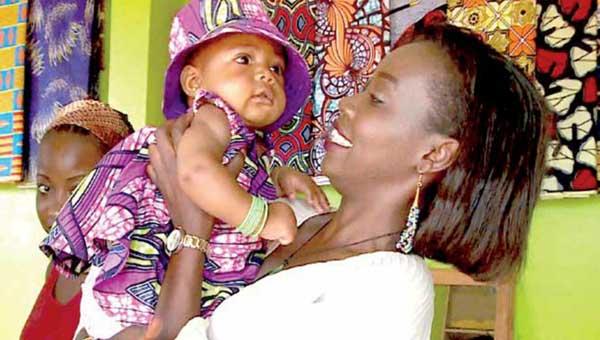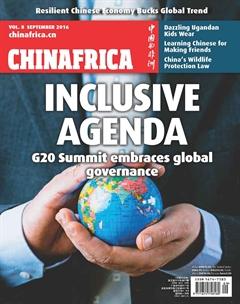Out of Africa
By Godfrey Olukya

Agnes Nanawulaips on a soft drink at a Kampala restaurant and watches her two-year-old daughter dressed in a brightly colored outfit playing nearby. “I bought this kids wear from a shop at Wandegeya on the outskirts of Kampala two weeks ago. I like this fashion style as it is simple but very beautiful. The cloth is pure cotton and comfortable for my kid,” the 30-year-old mother told ChinAfrica.
The label on the childs garment reads “Sawe Baby Wear.”
Its a label that is becoming more visible across the Ugandan capital and other cities in country. The clothing range is made from the pure cotton cloth known locally as Kitengi and is gaining popularity not only for its unique fashion style, but also because it is affordable.
The creative force behind the label said she was initially inspired by Chinas cottage industry success.
“When I learnt that Chinas local population has developed a lot through the establishment of cottage industries, I also decided to start an income generating activity at home,” 29-year-old Catherine Sawe, founder of Sawe Baby Wear told ChinAfrica.
A gift of an idea
Sawe said it all started out as something fun to do. Her childhood friend was pregnant and was expecting her baby soon. Part of tradition among many young women in Uganda is to hold a “baby shower” for expectant moms.
On such occasions, each friend donates a gift for the baby. Gifts typically include baby powder, baby soap, towels, shoes and so on.
However the talented Sawe gave her friend a gift she had made herself on the family sewing machine.
“I looked for an African inspired gift [and couldnt find one, so] I personally made booties, bibs and a dress. All the guests, especially parents and those expecting to become parents, were mesmerized by my gifts,” she said.
It wasnt long before she was getting orders for similar childrens wear from friends who had seen her designs. “After making kids wear for some of those who had placed orders, I realized that I could survive on making these outfits,” she said.
Who is Sawe?
Sawe holds a degree in industrial fine art from Makerere University in Uganda, where she learnt valuable tailoring and design skills. After graduating in early 2013 she had a stint as a painter, tour operator and manager of a cosmetics company. It was events that followed on from the “baby shower” in November 2015 that led to her abandoning being employed and instead becoming an employer.
“In January 2016, I started making kids wear at home[fulltime]. When the number of orders increased, I employed a tailor to help me.”
After two months she was overwhelmed by orders and not only rented a place to operate from, but also employed more people. Currently she has six tailors on her payroll, producing the labels dresses, shirts, hats, trousers, bibs and booties, and while she likes to keep her hand in as far as tailoring is concerned, Sawe now spends more time on marketing and quality control.
Marketing is made easier because of the brightcolored Kitengi fabric. Sawe said kids are more attracted to bright colors than dull colors.
“I carried out a study and learnt about the power and psychology of color on kids, especially when it comes to garments,” she said.
The garments are clearly attractive to children. Stella Acire, a mom in her 20s in Kampala, told ChinAfrica both she and her four-year-old daughter loved the color and design.
“I walked into a shop with my daughter and requested her to pick a dress she liked most. She picked the [Sawe Baby Wear] one she is now wearing. When she tried it on, she looked great so I bought it for her,”said Acire.
The label has a range for boys as well and caters for newly-borns to six-year-olds. Sawe said that apart from the color and design, the children also like the clothes because the style makes them look like their parents.
Local is best
One of Sawes greatest motivating factors in her business is that she wants to put Uganda and Africa on the kids wear map.
“I am not happy about Ugandans and Africans at large for always copying from Western countries. Most of the clothes we wear here are fashions adopted from the West. That is the reason why I use Kitengi material when making kids wear,” she said passionately.
The colorful cloth originates from the Democratic Republic of the Congo (DRC), which sees a stream of regular traders from East Africa travel to the DRC to stock up on Kitengi fabric. It is commonly used to make traditional adult garments worn at social gatherings and festivals.
Sawes plan to get Uganda noticed as an innovative kids wear manufacturer seems to be taking off. She said that after a recent interview on China Central Television (CCTV), business is looking good.
“My business has grown a lot in the last few months, especially after being featured recently by CCTV. I got calls from all over the world. I now export [my products] to Turkey, the United States, New Zealand, Kenya and other East African countries,”she said.
Exports average between 300 and 500 sets of kids wear per month, while local sales, including online, exceed 600 sets per month. Currently, a set of kids wear costs 70,000 Ugandan shillings ($20), which Sawe said her clients find affordable.
Looking ahead
Sawe said her future plans revolve around providing more employment opportunities, most notably to young people. As part of this initiative, she has partnered with a local NGO, the Remnant Generation, to teach teenage mothers who dropped out of school due to early pregnancies tailoring skills. Once trained, these young moms can be employed on a fulltime basis.
She also has her sights set firmly on the Chinese market. “I would like to start exporting kids wear to China. So far I do not have much money to use in getting to China to open up markets, but I hope that soon I may start getting orders from there.”
Along with these ambitions are the challenges Sawe faces - with her biggest headache being lack of capital to produce large export quantities and export wholesale.
“I get more orders than I can satisfy because of my small capital base,” she lamented.
Kampalas ongoing power blackouts and high electricity tariffs are also holding back production.
However Sawe remains optimistic, both as a role model to other African women in relation to what can be achieved as a single woman in a short space of time and in getting the Western world to sit up and take notice of her trendy kids clothing range.

